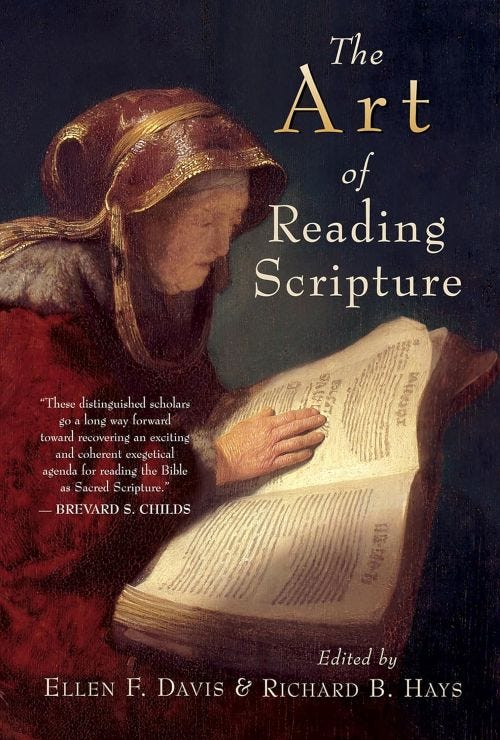Theological Interpretation of Scripture Matters—13
The Marks of Theological Interpretation of Scripture
What is theological interpretation of Scripture?
Some have found it much easier to say what theological interpretation isn’t, and others have grumbled about its apparent lack of a discernible method.
Even if it is true that theological interpretation is known more by certain sensibilities and aims, most of us still want to do better than former United States Supreme Court Justice Potter Stewart did when he tried to define the line between art and pornography, between free speech and obscenity: “I know it when I see it” (Jacobellis v. Ohio, 378 U.S. 184 [1964]).
One way to give some definition to the enterprise of theological interpretation of Scripture is to articulate its characteristic features, and several practitioners have given themselves to this task. Let me mention three:
Kevin J. Vanhoozer
Almost twenty years ago, at a conference on “Renewing the Evangelical Mission,” Vanhoozer sketched ten theses. [Michael Bird, “Kevin Vanhoozer’s Ten Theses on Theological Interpretation,” ΕΥΑΓΓΕΛΙΟΝ (17 October 2009).]
The nature and function of the Bible are insufficiently grasped unless and until we see the Bible as an element in the economy of triune discourse.
An appreciation of the theological nature of the Bible entails a rejection of a methodological atheism that treats the texts as having a “natural history” only.
The message of the Bible is “finally” about the loving power of God for salvation (Rom. 1:16), the definitive or final gospel Word of God that comes to brightest light in the word’s final form.
Because God acts in space-time (of Israel, Jesus Christ, and the church), theological interpretation requires thick descriptions that plumb the height and depth of history, not only its length.
Theological interpreters view the historical events recounted in Scripture as ingredients in a unified story ordered by an economy of triune providence.
The Old Testament testifies to the same drama of redemption as the New, hence the church rightly reads both Testaments together, two parts of a single authoritative script.
The Spirit who speaks with magisterial authority in the Scripture speaks with ministerial authority in church tradition.
In an era marked by the conflict of interpretations, there is good reason provisionally to acknowledge the superiority of catholic interpretation.
The end of biblical interpretation is not simply communication—the sharing of information—but communion, a sharing in the light, life, and love of God.
The church is that community where good habits of theological interpretation are best formed and where the fruit of these habits are best exhibited.
Richard B. Hays
Writing in the first issue of the Journal of Theological Interpretation, Hays spoke of “Reading the Bible with the Eyes of Faith: The Practice of Theological Exegesis” (Journal of Theological Interpretation 1, no. 1 [2007]: 5–21). An earlier version of this essay was presented as a main paper at the conference “Preaching, Teaching, and Living the Bible,” sponsored by the Center for Catholic and Evangelical Theology at Duke Divinity School (2006). [For access to this article, see below.]
Theological exegesis is a practice of and for the church.
Theological exegesis is self-involving discourse. Interpreters who read the Bible theologically approach the text with an awareness that we are addressed and claimed by the word of God that is spoken in the text, and we understand ourselves to be answerable to that word.
Historical study is internal to the practice of theological exegesis. The reasons why this is so are themselves fundamentally theological: God has created the material world, and God has acted for the redemption of that world through the incarnation of the Son in the historical person Jesus of Nazareth.
Theological exegesis attends to the literary wholeness of the individual scriptural witnesses.
Theological exegesis can never be content only to describe the theological perspectives of the individual biblical authors; instead, it always presses forward to the synthetic question of canonical coherence.
Theological exegesis does not focus chiefly on the hypothetical history behind the biblical texts, nor does it attend primarily to the meaning of texts as self-contained works of literature; rather, it focuses on these texts as testimony.
The language of theological exegesis is intratextual in character.
Theological exegesis, insofar as it stays close to the language and conceptuality of the NT witnesses, will find itself drawn into the Bible’s complex web of intertextuality.
Theological exegesis … is committed to the discovery and exposition of multiple senses in biblical texts. … Texts have multiple layers of meaning that are disclosed by the Holy Spirit to faithful and patient readers.
Learning to read the text with eyes of faith is a skill for which we are trained by the Christian tradition.
Theological exegesis … goes beyond repeating traditional interpretations; rather, instructed by the example of traditional readings, theological interpreters will produce fresh readings, new performances of Scripture’s sense that encounter the texts anew with eyes of faith and see the ways that the Holy Spirit continues to speak to the churches through the same ancient texts that the tradition has handed on to us.
When we speak of theological exegesis, particularly when we acknowledge the Spirit’s role, we must always remember that we are speaking not chiefly of our own clever readings and constructions of the text, but rather of the way that God, working through the text, is reshaping us.
Brad East
East has contributed to theological interpretation in a number of publications, both books and essays—including his article, “What Are the Standards of Excellence for Theological Interpretation of Scripture?,” Journal of Theological Interpretation 14, no. 2 (2020): 149–79. What are those standards? [For access to this article, see below.]
Doxological: Scriptural reading is in service of and encompassed by the glory of the triune God.
Spiritual: Scriptural reading is a spiritual affair, which is to say, it is an element in the ongoing work of the Holy Spirit’s sanctification of sinful believers.
Evangelical: Scriptural reading is intimate with the gospel because the matter of Scripture is Jesus Christ, and the name of Jesus Christ is the good news of God.
Edifying: Scriptural reading has, among its ends, the twofold telos of building up the church in love and knowledge of God and neighbor—each in that order.
Jubilaic: Scriptural reading is accountable to the divine preferential option for the poor.
Fruitful: Scriptural reading should bear fruit, that is, issue in living active response and obedience; further, it must be received, considered, disputed, [and] enacted in the community of faith.
Prophetic: Scriptural reading is … an occasion for God’s people to respond, “The word of the Lord.” It is, that is to say, an occasion for human words to bear divine speech, for God’s word to be given us, for prophecy.
Penitent: Scriptural reading is between the times and so an activity of sanctified sinners on the way.
Each of these practitioners has approached the task in different ways. For example, are we talking about assumptions, approaches, aims, or something else altogether? Even so, outlines like these help us to construct what we might call a “family resemblance” model for recognizing interpreters who, and interpretations that, belong to a long lineage, a global and historical tradition of practice, we today call theological interpretation of Scripture.
Recommended Reading
[Note: As an Amazon Associate, I may earn a small commission if you click through and make a purchase. This doesn’t affect the price you pay and helps support this website.]
Ellen F. Davis and Richard B. Hays, eds., The Art of Reading Scripture (Grand Rapids: Eerdmans, 2003). ISBN 9780802812698. 354 pp.
This collection of essays includes an impressive bevy of contributors—in addition to the editors, e.g., Richard Bauckham, Brian Daley, Marianne Meye Thompson, and Walter Moberly. Nine Theses on the interpretation of Scripture head the volume, and the essays and sermons that follow “both amplify and model” the approach to Scripture they urge. The volume, which grew out of a “Scripture Project” concerned with academic theology and the life of the church, “proposes a quiet revolution” in the way the Bible is used and taught.
To access copies of the essays by Hays and East (PDFs), be sure that you are subscribed to this substack (three levels: annual, monthly, and free).



